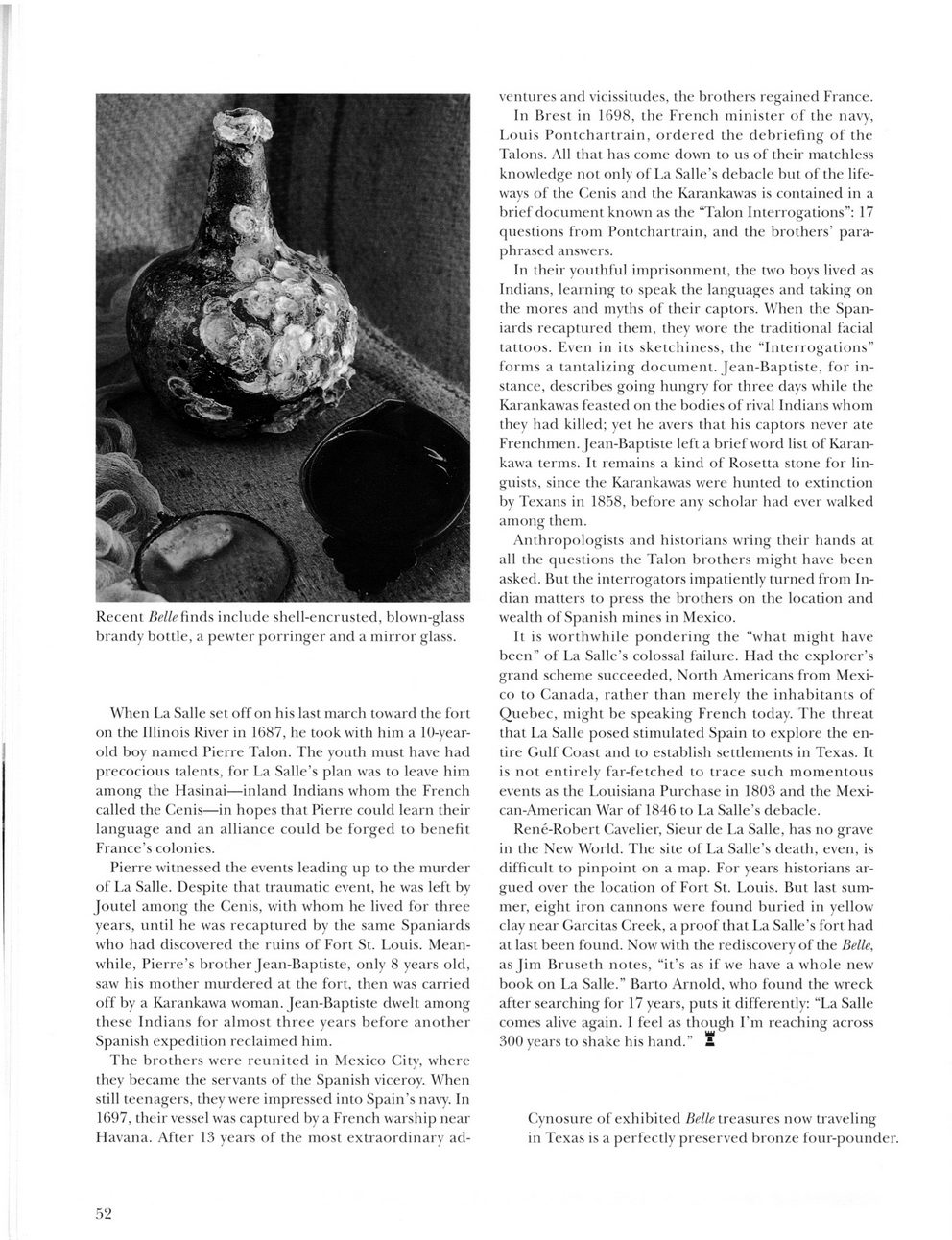This text was obtained via automated optical character recognition.
It has not been edited and may therefore contain several errors.
I >li i m Recent Belle finds include shell-encrusted, blown-glass brandv bottle, a pewter porringer and a mirror glass. When La Salle set off on his last march toward the fort on the Illinois River in 1687, he took with him a 10-year-old boy named Pierre Talon. The youth must have had precocious talents, for La Salle?s plan was to leave him among the Hasinai?inland Indians whom the French called the Cenis?in hopes that Pierre could learn their language and an alliance could be forged to benefit France?s colonies. Pierre witnessed the events leading up to the murder of La Salle. Despite that traumatic event, he was left by Joutel among the Cenis, with whom he lived for three years, until he was recaptured by the same Spaniards who had discovered the ruins of Fort St. Louis. Meanwhile, Pierre?s brother Jean-Baptiste, only 8 years old, saw his mother murdered at the fort, then was carried off by a Karankawa woman. Jean-Baptiste dwelt among these Indians for almost three years before another Spanish expedition reclaimed him. The brothers were reunited in Mexico City, where they became the servants of the Spanish viceroy. When still teenagers, they were impressed into Spain?s navy. In 1697, their vessel was captured by a French warship near Havana. After 13 years of the most extraordinary ad- ventures and vicissitudes, the brothers regained France. In Brest in 1698, the French minister of the navy, Louis Pontchartrain, ordered the debriefing of the Talons. All that has come down to us of their matchless knowledge not only of La Salle?s debacle but of the life-ways of the Cenis and the Karankawas is contained in a brief document known as the ?Talon Interrogations?: 17 questions from Pontchartrain, and the brothers? paraphrased answers. In their youthful imprisonment, the two boys lived as Indians, learning to speak the languages and taking on the mores and myths of their captors. When the Spaniards recaptured them, they wore the traditional facial tattoos. Even in its sketchiness, the ?Interrogations? forms a tantalizing document. Jean-Baptiste, for instance, describes going hungry for three days while the Karankawas feasted on the bodies of rival Indians whom they had killed; yet he avers that his captors never ate Frenchmen. Jean-Baptiste left a brief word list of Karankawa terms. It remains a kind of Rosetta stone for linguists, since the Karankawas were hunted to extinction by Texans in 1858, before any scholar had ever walked among them. Anthropologists and historians wring their hands at all the questions the Talon brothers might have been asked. But the interrogators impatiently turned from Indian matters to press the brothers on the location and wealth of Spanish mines in Mexico. It is worthwhile pondering the ?what might have been? of La Salle?s colossal failure. Had the explorer?s grand scheme succeeded, North Americans from Mexico to Canada, rather than merely the inhabitants of Quebec, might be speaking French today. The threat that La Salle posed stimulated Spain to explore the entire Gulf Coast and to establish settlements in Texas. It is not entirely far-fetched to trace such momentous events as the Louisiana Purchase in 1803 and the Mexi-can-American W'ar of 1846 to La Salle?s debacle. Rene-Robert Cavelier, Sieur de La Salle, has no grave in the New Wrorld. The site of La Salle?s death, even, is difficult to pinpoint on a map. For years historians argued over the location of Fort St. Louis. But last summer, eight iron cannons were found buried in yellow clay near Garcitas Creek, a proof that La Salle?s fort had at last been found. Now with the rediscovery of the Belle, as Jim Bruseth notes, ?it?s as if we have a whole new book on La Salle.? Barto Arnold, who found the wreck after searching for 17 years, puts it differently: ?La Salle comes alive again. I feel as though I?m reaching across 300 years to shake his hand.? ? Cynosure of exhibited Belle treasures now traveling in Texas is a perfectly preserved bronze four-pounder. 52

LaSalle 009